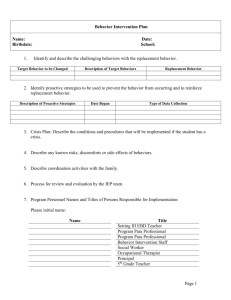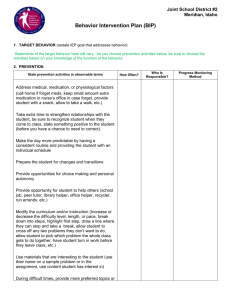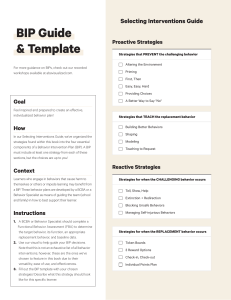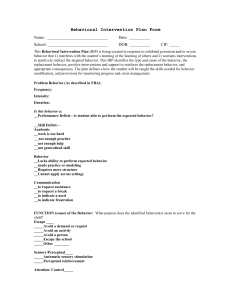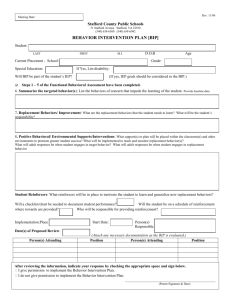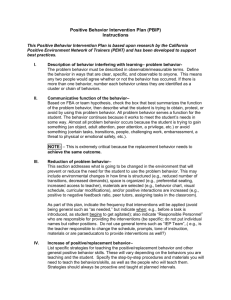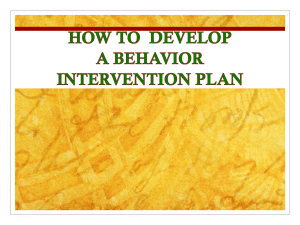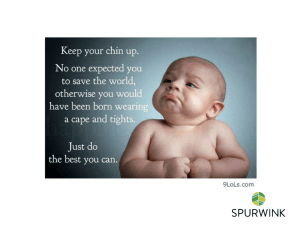Behavior Intervention Plan with cues (revised 9/11/13)
advertisement
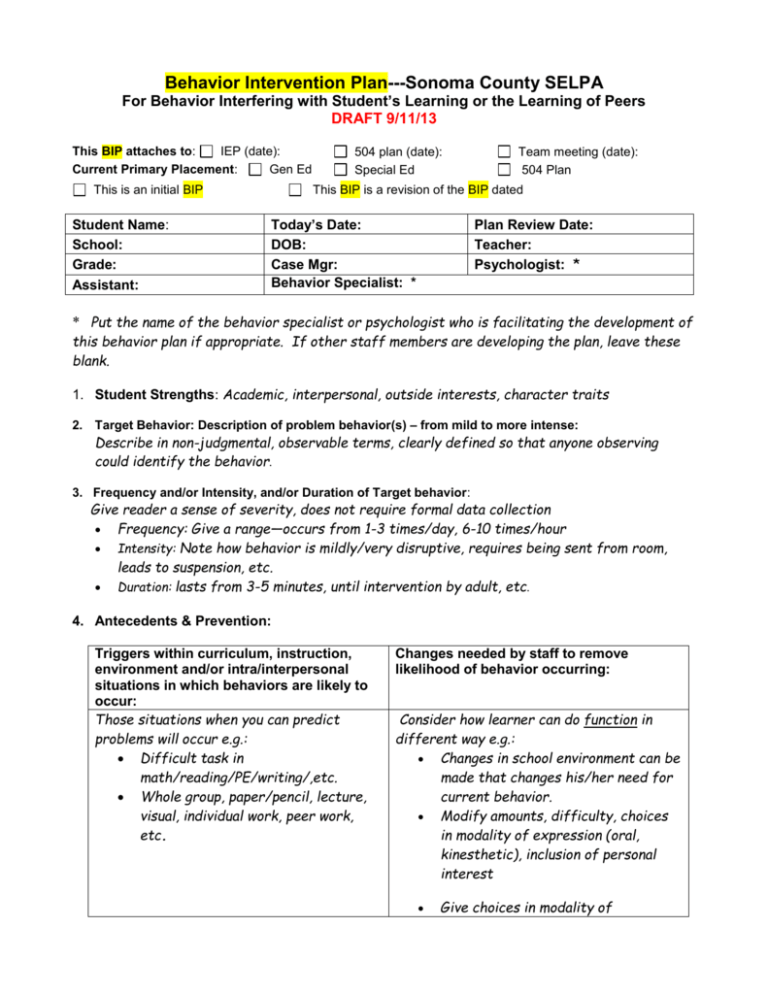
Behavior Intervention Plan---Sonoma County SELPA For Behavior Interfering with Student’s Learning or the Learning of Peers DRAFT 9/11/13 This BIP attaches to: IEP (date): Current Primary Placement: Gen Ed This is an initial BIP Student Name: School: Grade: Assistant: 504 plan (date): Special Ed Team meeting (date): 504 Plan This BIP is a revision of the BIP dated Today’s Date: DOB: Case Mgr: Behavior Specialist: * Plan Review Date: Teacher: Psychologist: * * Put the name of the behavior specialist or psychologist who is facilitating the development of this behavior plan if appropriate. If other staff members are developing the plan, leave these blank. 1. Student Strengths: Academic, interpersonal, outside interests, character traits 2. Target Behavior: Description of problem behavior(s) – from mild to more intense: Describe in non-judgmental, observable terms, clearly defined so that anyone observing could identify the behavior. 3. Frequency and/or Intensity, and/or Duration of Target behavior: Give reader a sense of severity, does not require formal data collection Frequency: Give a range—occurs from 1-3 times/day, 6-10 times/hour Intensity: Note how behavior is mildly/very disruptive, requires being sent from room, leads to suspension, etc. Duration: lasts from 3-5 minutes, until intervention by adult, etc. 4. Antecedents & Prevention: Triggers within curriculum, instruction, environment and/or intra/interpersonal situations in which behaviors are likely to occur: Those situations when you can predict problems will occur e.g.: Difficult task in math/reading/PE/writing/,etc. Whole group, paper/pencil, lecture, visual, individual work, peer work, etc. Changes needed by staff to remove likelihood of behavior occurring: Consider how learner can do function in different way e.g.: Changes in school environment can be made that changes his/her need for current behavior. Modify amounts, difficulty, choices in modality of expression (oral, kinesthetic), inclusion of personal interest Give choices in modality of Transitions, near certain peers, on floor, unstructured times, when room temperature is hot, large groups Face is pale, paces, coughs, prior problem (on bus to school, at home) Certain peers/adults present, when bullied, peer situation where student has social skill deficit expression, pacing, materials Changes in seating, choice of work spaces, alternate location for unstructured times, change in personal space (stands at front of line) 5. Function of Behavior: i.e., to get or obtain, to avoid or escape, and/or sensory regulation What is the student getting (social status, peer or adult attention, desired object or activity) or escaping/avoiding (difficult work, peer actions, interaction style of an adult, etc.) with this behavior? 6. Replacement Behaviors: describe & define an acceptable alternate behavior that meets the same function of the target behavior In the future, how will s/he get needs met that this behavior fulfilled, e.g. something desired, or something to be escaped or avoided when necessary? 7. Instructional Strategies to Teach the Replacement Behaviors/Skills to the Student: List successive teaching steps for student to learn replacement behavior(s) 8. Reinforcement Procedures to use for establishing, maintaining and generalizing the replacement behaviors: Consider a range of non-intrusive ones: simple praise statements the student enjoys, privately given specific praise, notes home, contingent access to favorite classroom activities or privileges, high ‘5’. What motivates the student and enhances quality of life right now? Who will give? Maximize sources of reinforcement. Will reinforcement happen in school and at home or by outside school or community personnel? How frequently? When learning new behavior—high frequency, reducing as mastered. 9. Reactive Strategies to use when the target behavior occurs - from mild to more intense: Prompt the replacement behavior What works to calm the student? How can you best prevent escalation? Will structured choice help? Offering ‘Time Away’ to cool off non-emotionally? What series of behaviors should adults employ to return the student to rule-following behavior. Will consequences such as expulsion/suspensions be necessary? Exactly under what conditions? If physical restraints are to be used, add under what conditions will they be used, by whom and where have staff been trained in the use of restraint procedures? 10. Communication: How, to whom, (all participants) and at what frequency, will the progress/data be reported? Revised 9/11/13 Method: Between: Frequency: What system? Phone calls by whom to whom? Informal notes? Daily report cards? Weekly logs? Consider family, administrators, IEP team, counselors, probation officer, and other agencies. 11. Data Collection following Implementation of this Plan: Target Behavior (how often, by whom) o Frequency, intensity and/or duration o Who will collect the data? Replacement Behavior (how often, by whom) o Frequency of new replacement behavior o Who will collect the data? 12. Criteria for Success: (How will plan be faded? How will you know when the plan is successful?) Student will independently request a break to the goal criteria, engage in self-regulatory skills to the goal criteria, etc. Student will no longer receive tangible reinforcers following 80% of success Participants in the Plan Development: Student _____________________________ Administrator ____________________________ Parent/Guardian ______________________ Parent/Guardian __________________________ Educator & Title _______________________ Educator & Title __________________________ Occupational Therapist _________________ Behavior Specialist ________________________ Speech Therapist ______________________ Other ___________________________________ Psychologist _________________________ Other ___________________________________ * Reminder for students with IEPs: Behavior Goal(s) need to be added to SELPA form #4 (goal page) What new skills will student achieve through this plan, not just a decrease in problem behavior. Should address replacement behaviors. Goal # : By (date), instead of (problem behavior), to achieve (function), (student) will do (replacement behavior), under what conditions, at what level of proficiency, as measured by whom and by what means. Who will collect assessment data? Revised 9/11/13 How will data be collected?
